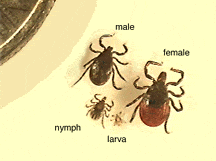
View this u-tube from Dr Klinghardt
Although Lyme disease is said to have been first discovered in 1977, after a mysterious outbreak of arthritis near the town of Lyme, Connecticut, it was actually first identified in Germany in 1883, in the town of Breslau. (1) Conventional wisdom asserts that Lyme disease is relatively rare and only transmitted by ticks. In actuality, it is now an epidemic; and it can be spread by other insects, not just ticks- fleas, mosquitoes, mites, and flies. There has also been a correlation with the transmission of Lyme via human-to-human contact, blood transfusion and including breast feeding.[Dr. Katrina Tang, M.D., H.M.D., Reno Nevada]
With 35,198 new cases reported to the US Centers for Disease Control (CDC) in 2008, "Lyme disease accounts for 90% of all vector-borne infections" in the US.(2) In fact, the CDC estimates the number of actual cases to be 6 to 12 times higher than reported. (3)
Although Lyme is typically identified by an initial rash- a "bulls-eye" rash, only 30 to 40% of adults with Lyme disease and less than 10% of infected children exhibit the "bulls eye" rash. Because of these numbers, Lyme disease-if left untreated, inevitably spreads throughout the body.
Symptoms of Lyme disease in early and late stages of dissemination are variable and include Chronic fatigue; headache; weakness; muscle pain and swelling; chills; fever; sore throat; nausea; vomiting; facial paralysis; swollen lymph glands; enlarged spleen; profuse perspiration; irregular heartbeat; seizures; blurry vision; memory loss; cranial and Bell;s palsy; impaired muscle coordination; gait problems; stabbing pains along the extremities; diminished reflexes; brain and spinal cord infection; bladder and kidney problems; infertility; liver problems and skin disorders. Depression has been noted, by Vanderhoof-Forschner where it has affected as many as 1/3 all Lyme disease patients. Other disorders in this category include mood swings, dementia, personality changes, hallucinations, panic attacks, impulsive violence, paranoia, schizophrenia and eating disorders (4). Lyme disease can also be a cause of other degenerative diseases such as ALS, Alzheimer's, fibromyalgia, and MS.
The main reason that Lyme is so resistant to detection and therapy is that it is pleomorphic, meaning it can radically change form- cell wall deficient. This means that it doesn't have a fixed exterior membrane presenting information- a target- that would allow our immune system or drugs to attack it. Because of this the testing may not be valid. Several researchers have noted that because it is extremely diverse in its appearance, its activity, and its vulnerability, one can't expect any one antibiotic to be effective. Also, bacteria share genetic material with one another, so the offspring of the next generation may have a new genetic sequence that can resist the antibiotic.
Treating Lyme disease effectively involves a comprehensive, knowledgeable approach that integrates both western medicine and alternative medicine. If you have been diagnosed with Lyme or feel you may have Lyme disease and would like to work with us, as an alternative, please contact us.
References:
*Goldberg, Burton and Trivieri, Larry Chronic Fatigue, Fibromyalgia, and Lyme Disease 2004
1.Vanderhoof-Forschner, Karen. Everything you Need to Know About Lyme Disease and Other Tick-Borne Disorders. Hoboken NJ: John Wiley & Sons, Inc. 2003;39.
2. Centers for Disease Control. Notice to readers: Final 2008 reports of nationally notifiable infectious diseases. Morbidity and Mortality Weekly Report. 2009;58:856-857; 859-869
3. A.R 55, 212th Leg., reg. sess. (N) 2006 (enacted)
4. Ibid, 58
Please refer to the